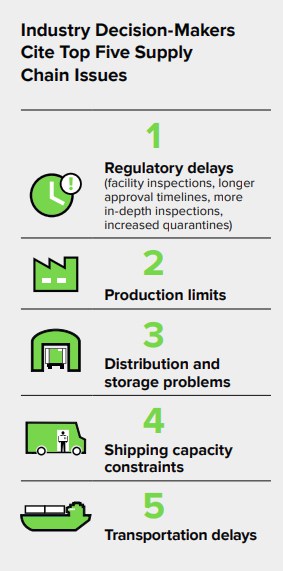Zebra Technologies’ Pharmaceutical Supply Chain Vision reveals patients’ distrust of the medications they are receiving and segments within the pharmaceutical supply chain, including the entities who manufacture, distribute, prescribe and dispense those drugs. Forty-three per cent fear more illness and/or death could result from contaminated or tainted medications without supply chain improvements.
Over three-quarters of patients surveyed from Asia-Pacific say more regulation of pharmaceuticals is needed, and nearly all (95%) decision-makers say better cooperation between government/regulatory agencies and pharmaceutical industry companies is needed to protect patients, the highest of any region.
The source of patients’ fears
Medication efficacy and safety are top of mind today with patients with three-in-four patients stating they are either somewhat or very concerned about the ineffectiveness of medication in helping with their condition or illness. And seven-in-10 are concerned about receiving:
- an improper dose due to labelling errors, and the harm it could potentially cause them.
- stolen, contaminated, tainted, expired, or counterfeit medicines.
- medications that were improperly handled/stored during transit and could have damage or diminished efficacy.
Patients know a compromised supply chain puts medication quality and efficacy at risk and want better assurances their medications are safe and authentic. Nine-in-10 say it is somewhat or very important they can verify a medication is not counterfeit nor tampered with and confirm temperature-sensitive medications have stayed within the prescribed range.
According to the survey, patients also expect drug manufacturers to disclose how their medications are manufactured/handled (81%) and transported/stored (82%). Eighty per cent say it’s also important to verify the sources of medication ingredients including the country of origin and local standards for the medication itself.
In addition, 79% of those surveyed want to know the source of their medication is sustainable with confirmation the manufacturer is using techniques to protect the environment, animal welfare, human communities, and public health.
“While meeting regulatory standards has been a primary focus for pharmaceutical industry leaders, these evolving patient demands have shown that more needs to be done,” said Christanto Suryadarma, Southeast Asia (SEA) sales vice president, Zebra Technologies.
He believed it is crucial for manufacturers, government agencies, pharmacies and healthcare providers to work hand-in-hand to win consumers’ trust in the supply chain.
The study shows that the pharmaceutical industry must work harder to prove they are putting patients’ needs first if they want to earn consumer confidence and loyalty on a grand scale.
Greater transparency and accountability

Over eight-in-10 patients agree government/regulatory agencies and pharmaceutical companies need to work better together to protect patients and ensure the medications they receive are safe and effective.
More than 40% of patients and pharmaceutical industry decision-makers say regulators, pharmaceutical companies and manufacturers are the ones most responsible for combatting counterfeit, stolen and contaminated medications.
The onus is being put on those who manufacture, dispense and administer medications to implement trustworthy safety protocols, with hospitals bearing the brunt of the responsibility in 57% of patients’ eyes.
Aik Jin Tan, vertical solutions lead, Zebra Technologies Asia Pacific, called for enhanced traceability and transparency across the supply chain.
"Technology-driven transparency will help address concerns like quality and temperature control, right medication, and substandard medication, thereby building long-term trust as a result,” he continued.
The majority of pharmaceutical industry decision-makers (84%) feel they are prepared to comply with traceability and transparency mandates.
Three-quarters confirm they have already deployed location services technology or plan to in the next year – a move which would improve production workflows and drug tracking, reduce shrink and tampering, and give patients the visibility and information they want.
The biggest challenge these leaders are facing is being able to make – and move – enough medications to meet patients’ needs. In addition to regulatory delays, industry decision-makers say they are also dealing with production limits, distribution and storage problems, shipping capacity constraints and transportation delays. Consequently, 92% plan to increase investments in pharmaceutical manufacturing and supply chain monitoring tools next year.
Problems at the point of sale
Over three-quarters of patients surveyed say they have experienced issues either purchasing or taking medication in the past, with millennials (82%) remarkably reporting more issues than Boomers (61%). Millennials don’t tolerate mistakes, though, and are twice as likely as Boomers to change pharmacies to find one that can meet their needs. And 70% of all patients confirmed they have either changed prescribing providers, pharmacies, or medications in the past due to a poor experience.
Among patients experiencing problems, a severe side effect was among the top five issues. But it was not the most prevalent:
- Needed medication that was unavailable or out of stock (32%)
- Received only a partial amount due to unavailability at the time (29%)
- Found the same product at a lower price elsewhere (27%)
- Did not receive on time or when needed (22%)
- Experienced a severe side effect (21%)
Most patients’ lingering concerns centre on medication affordability (76%) and shortages (73%). However, drug administrators are not off the hook for safety and efficacy. Eighty-five per cent of patients say all pharmacies need to monitor the medications dispensed, including mail-order pharmacies.





